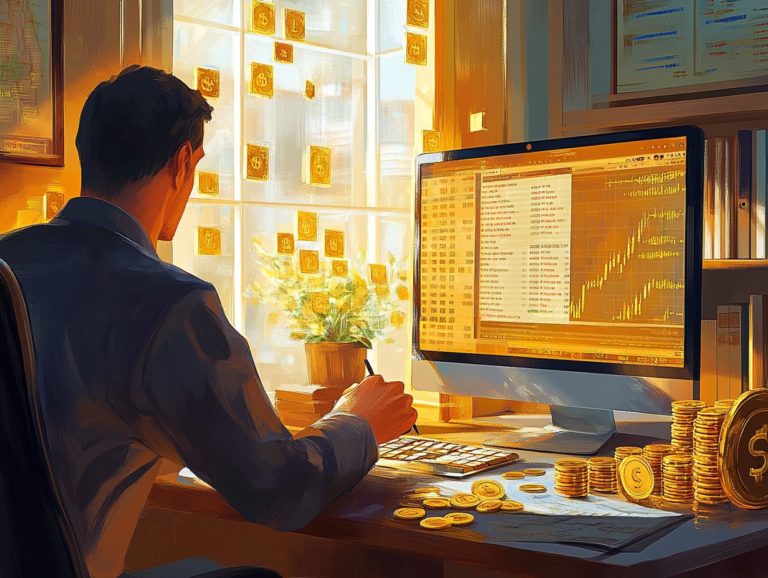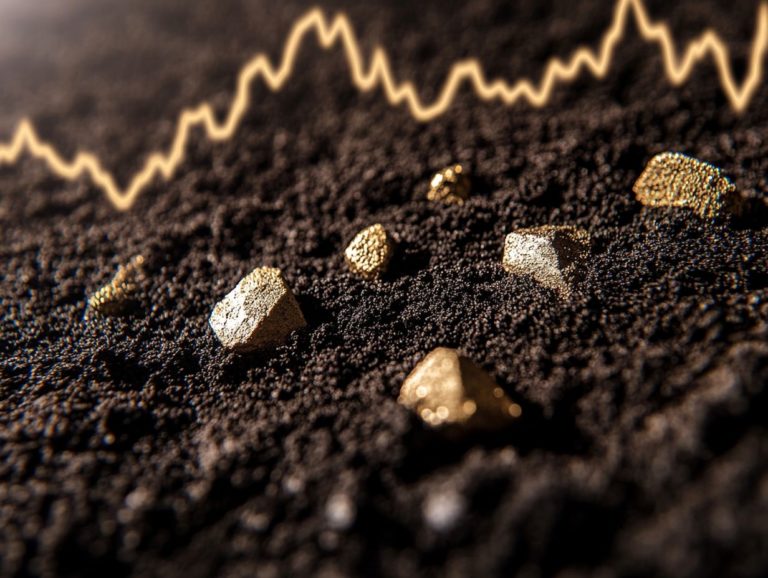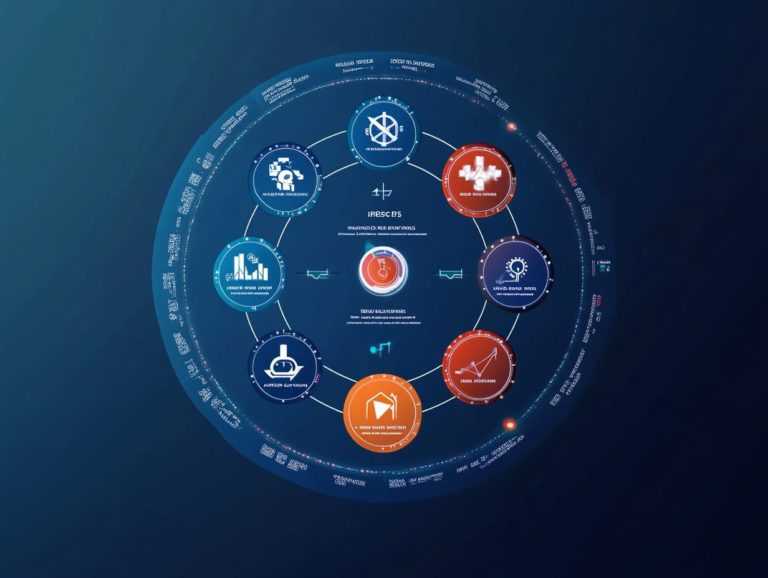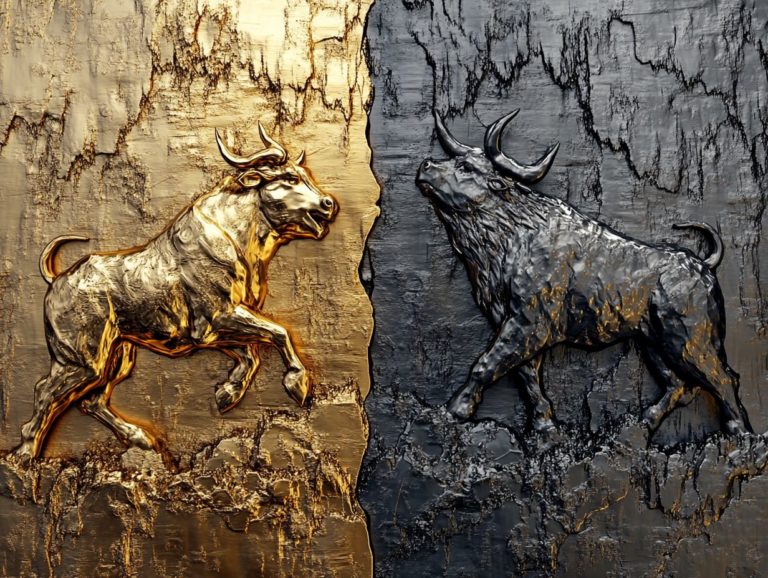The Impact of Inflation on Precious Metals
Inflation stands as a pivotal economic indicator that can shape everything from how much you can buy with your money to your investment strategies. As prices rise, understanding the causes and effects of inflation is crucial for informed financial decisions.
This article delves into the intricate relationship between inflation and precious metals, examining historical trends, market dynamics, and why these assets are frequently regarded as a stable hedge.
You’ll uncover effective investment strategies suitable for this volatile environment, alongside the potential risks that warrant your attention.
Embark with us on this journey through the complexities of inflation, and learn how adding precious metals to your financial portfolio can be a smart and timely decision!
Contents
- Key Takeaways:
- Understanding Inflation and Its Effects
- The Role of Precious Metals in Inflation
- Factors That Influence Precious Metals During Inflation
- Investing in Precious Metals During Inflation
- Frequently Asked Questions
- What is the impact of inflation on precious metals?
- How does inflation affect the price of precious metals?
- What is the historical relationship between inflation and precious metals?
- How can precious metals protect against inflation?
- Are all precious metals impacted by inflation in the same way?
- What other factors can impact the relationship between inflation and precious metals?
Key Takeaways:
- Inflation is a sustained increase in the overall price level of goods and services, caused by factors such as money supply and consumer demand.
- Precious metals have a historical track record of retaining their value and serving as a hedge against inflation.
- Factors such as supply and demand, interest rates, and currency values can significantly impact the prices of precious metals during inflation.
Understanding Inflation and Its Effects
Inflation is an essential economic phenomenon that signifies a general rise in the prices of goods and services over time. This trend significantly influences your consumer behavior, investment strategies, and financial planning.
Recently, you may have noticed notable fluctuations in the consumer price index, largely driven by increasing interest rates from central banks like the US Federal Reserve, along with external factors such as geopolitical tensions and shifting market demand.
By grasping the intricacies of inflation and its effects, you can gain valuable insights into economic trends and discover promising investment opportunities.
Definition and Causes of Inflation
Inflation is the rate at which the general level of prices for goods and services rises, subtly eroding your purchasing power and influencing the broader economy.
This phenomenon can take on various forms. One prominent type is demand-pull inflation, which occurs when demand outpaces supply, resulting in climbing prices. On the other hand, you might encounter cost-push inflation, which emerges from surging production costs, compelling businesses to pass these expenses on to you, the consumer. There’s also built-in inflation, which can arise from a wage-price spiral; as wages increase, so do costs for goods and services.
Central banks, like the US Federal Reserve, play a pivotal role in managing inflation. They adjust interest rates and implement actions taken by central banks to control the money supply and interest rates aimed at stabilizing the economy. Their goal is to find a balance that fosters sustainable growth without triggering rampant price increases, ultimately helping to maintain your confidence as a consumer and ensuring economic stability.
How Inflation Affects the Economy
Inflation can significantly impact the economy. As prices rise, you may find yourself adjusting your buying habits, perhaps leaning toward generic brands or postponing non-essential purchases. This shift in consumer behavior can create ripples throughout the economy, influencing local businesses and ultimately leading to changes in market prices.
For example, areas like housing and food can see rapid price increases, putting pressure on your household budget. Inflation can also create unique investment opportunities. Investors often gravitate toward precious metals, which typically act as a hedge against rising prices. Understanding the importance of tax planning for precious metals investors is crucial, especially during inflationary periods when gold and silver often see a surge in demand, reflecting your growing concern for financial stability.
These trends highlight just how interconnected the various aspects of the economy really are.
The Role of Precious Metals in Inflation
Precious metals, especially gold and silver, hold a vital position in the financial landscape. They serve as an effective hedge against inflation, offering you a layer of security when traditional currencies begin to falter in value.
Historical Trends and Patterns
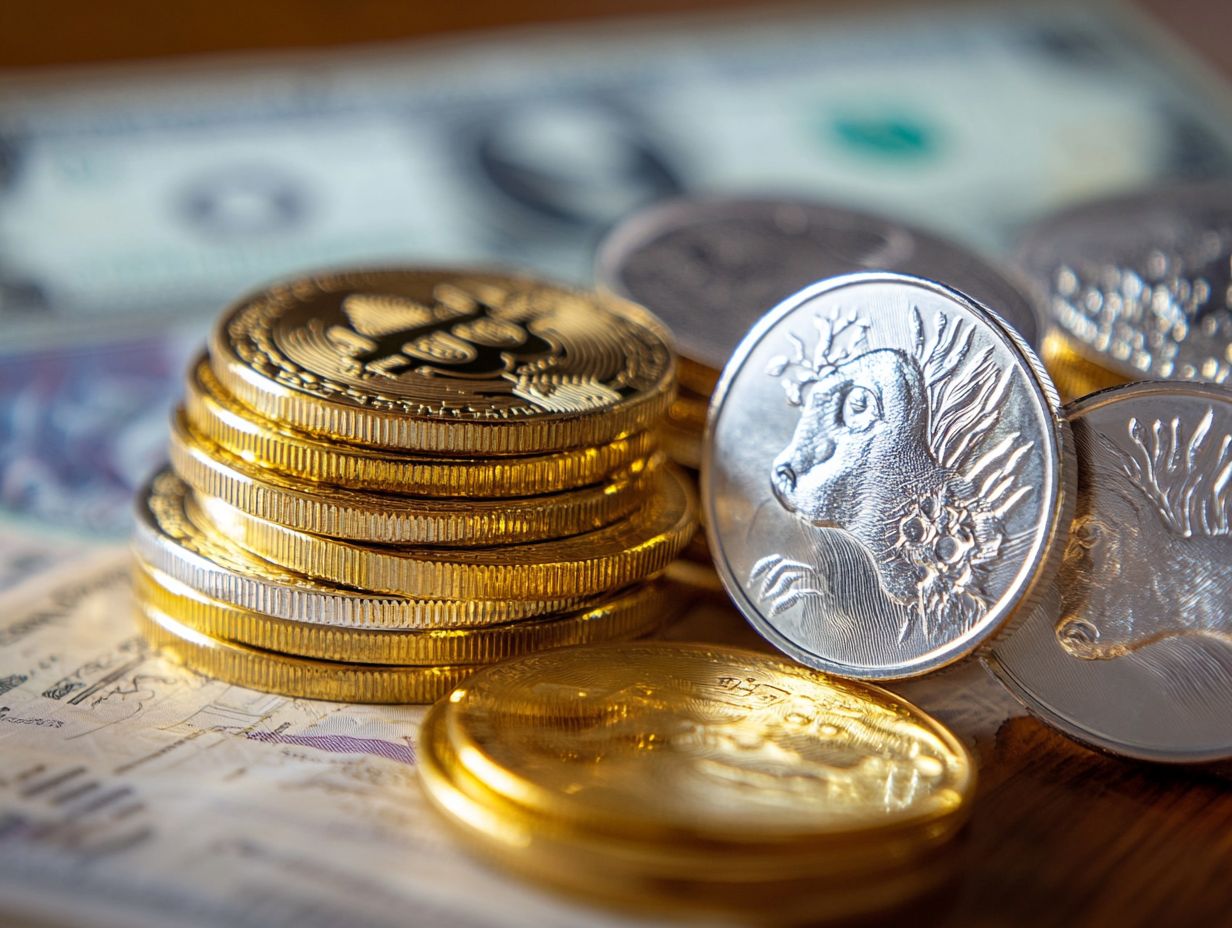
Historically, gold and silver have shown distinct patterns during inflationary periods. They frequently experience price surges as investors seek safe-haven assets.
This trend was particularly evident during significant inflation spikes, such as those in the 1970s. The U.S. faced double-digit inflation rates, and during that tumultuous time, gold prices soared from around $35 in 1971 to over $800 by 1980. This highlights the metal’s resilience in the face of economic uncertainty, as detailed in the impact of inflation on silver prices.
The inflationary pressures of 2022 similarly sparked renewed interest in these precious metals. Prices for gold and silver rose sharply as investors worried about eroding purchasing power.
By examining these historical events, it becomes evident that precious metals often serve as a steadfast hedge against inflation. They offer valuable insights into potential roles in modern financial strategies.
Why Precious Metals are a Popular Hedge Against Inflation
Investors often seek precious metals like gold and silver as reliable hedges against inflation. Their worth is proven during economic downturns.
These metals consistently hold their value over the centuries, acting as safe havens in turbulent times. Their worth is deeply rooted in their limited supply, which helps them withstand the devaluation pressures that often affect currencies issued by governments.
When inflation becomes a pressing concern, demand for these metals tends to surge as investors look to protect their wealth.
Don t miss out! Adding gold and silver to your portfolio can help shield you from inflation, paving the way for a more stable financial future.
Factors That Influence Precious Metals During Inflation
Several factors influence the performance of precious metals during inflationary periods:
- Supply and demand
- Shifts in interest rates
- Broader market conditions
Each of these elements plays a crucial role in shaping how precious metals respond to inflation, impacting their value and your investment strategy.
Supply and Demand Dynamics
The balance of supply and demand is pivotal in shaping the prices of precious metals, especially during inflationary periods.
As inflation escalates, the appeal of assets like gold and silver intensifies. Investors view them as safe havens.
This surge in demand often outstrips mining output, which faces obstacles from geopolitical tensions and operational difficulties that can disrupt supply chains.
For example, conflicts or new regulations in crucial mining regions can curtail production levels, tightening the market even further.
As investors seek these metals to protect against currency devaluation, the delicate interplay between dwindling supply and soaring demand significantly impacts price movements.
Interest Rates and Currency Values
Interest rates and currency values are closely linked, often shaping the performance of precious metals during inflation.
When central banks like the Federal Reserve raise interest rates, you may notice an immediate effect: a stronger US dollar.
A robust dollar typically dampens demand for gold and silver, as these metals become more expensive for investors holding other currencies.
Higher interest rates can make interest-bearing assets, such as bonds, far more attractive than non-yielding assets like gold and silver. This shift often leads to a decrease in investment in precious metals, leaving their prices vulnerable amid rising rates.
Savvy investors watch these central banking policies closely, recognizing the dynamic between interest rates and currency values is crucial in guiding their investment choices.
Investing in Precious Metals During Inflation
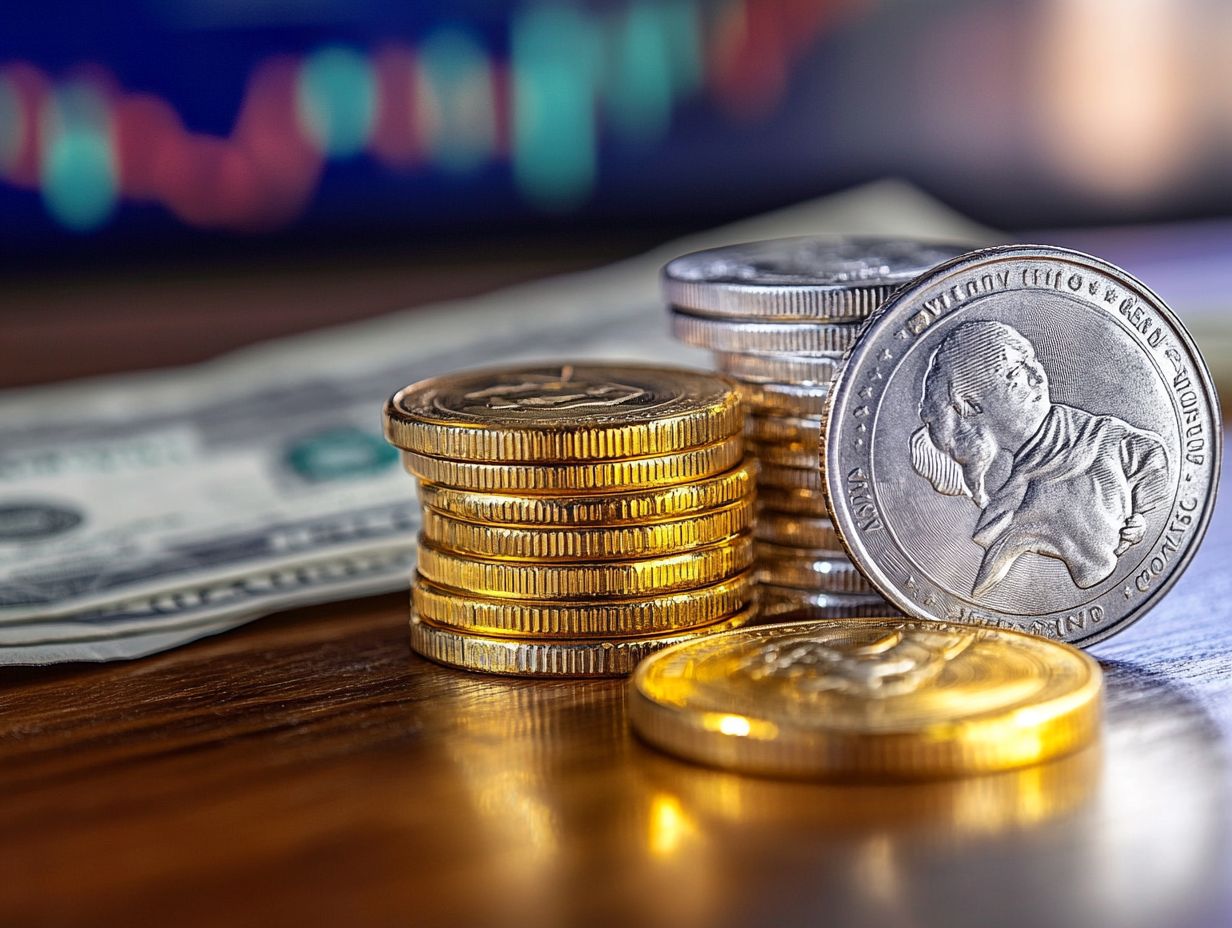
Investing in precious metals during periods of inflation demands a thoughtful approach and meticulous risk assessment.
By strategically planning your investments, you can maximize potential returns while effectively navigating inevitable market volatility.
Consider investing in gold and silver now to prepare for potential future inflation risks.
Strategies for Maximizing Returns
Maximizing returns on your precious metals investments during inflation requires a blend of strategic planning and keen market analysis.
As you navigate this intricate landscape, consider adopting a variety of strategies that emphasize diversification across different types of metals. By spreading your investments among gold, silver, platinum, and palladium, you can effectively reduce risk while capitalizing on market fluctuations.
Timing your purchases is key. Astute investors often wait for dips or downturns to make their moves, thereby enhancing potential returns. Keeping a close eye on economic indicators such as interest rates, inflation rates, and geopolitical tensions enables you to make better decisions.
Paying attention to these factors can significantly influence when and how much to invest, ultimately crafting a robust portfolio that can withstand market volatility.
Potential Risks and Considerations
Investing in precious metals during inflation can provide a sense of security. However, it’s crucial to be aware of the potential risks and considerations that come along with it.
Market volatility plays a significant role in the value of precious metals, leading to unpredictable price fluctuations. Factors such as changes in global demand, whether driven by consumer trends or industrial needs, can also affect prices. Additionally, you should consider geopolitical influences, including trade tensions and political instability, which can create uncertainty in the market. Understanding the effect of inflation on precious metals taxation is also crucial for making informed investment decisions.
If you are looking to diversify your portfolio with gold, silver, or platinum, staying informed and conducting thorough research is essential.
By understanding these risks, you can make empowered investment choices in the ever-evolving landscape of precious metals.
Frequently Asked Questions
What is the impact of inflation on precious metals?
Inflation can have both positive and negative impacts on precious metals. Generally, moderate inflation can increase demand for precious metals as a way to protect money from losing value. However, high inflation rates can lead to a decrease in purchasing power, ultimately reducing the value of precious metals.
How does inflation affect the price of precious metals?
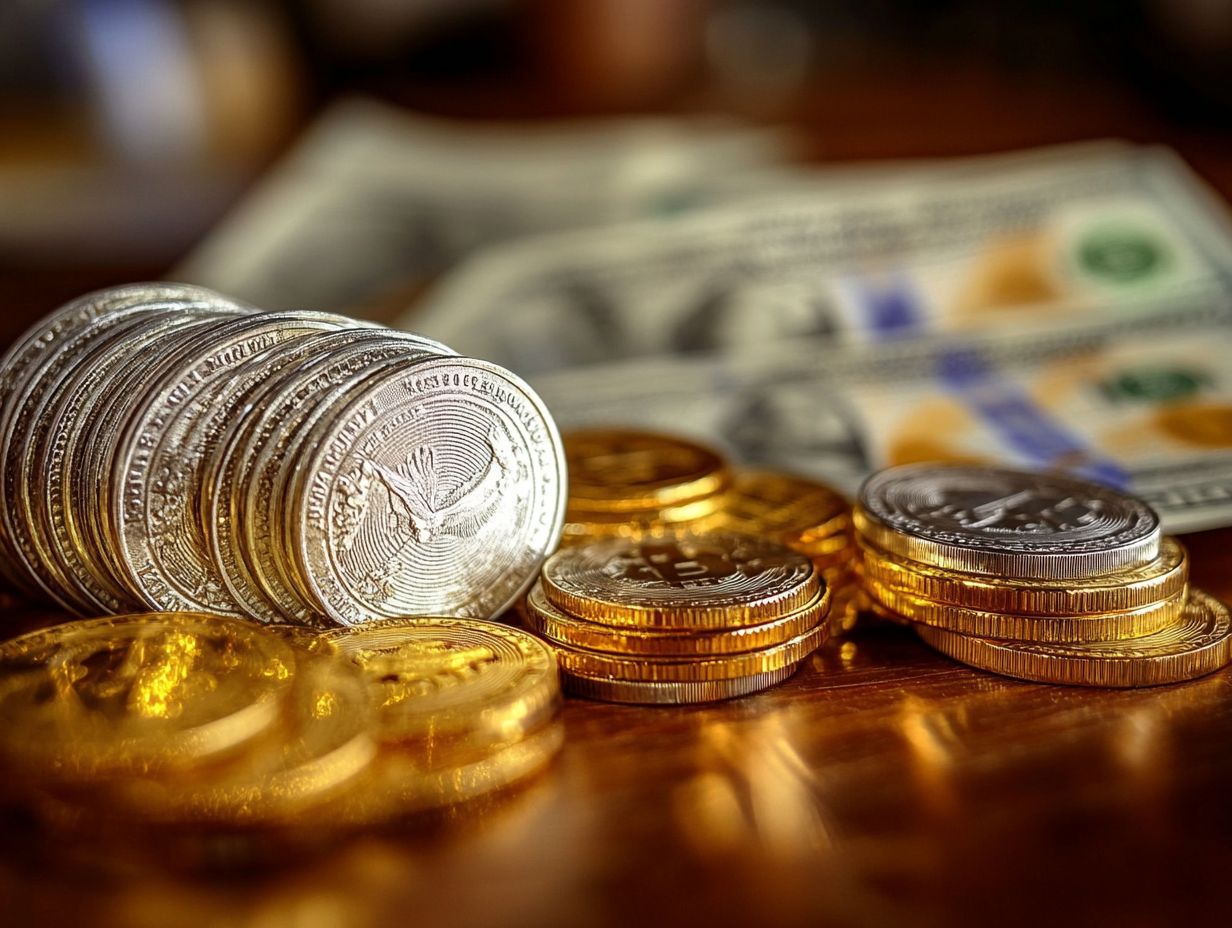
Inflation can cause the price of precious metals to rise due to their intrinsic value and limited supply. As the value of fiat currency decreases, investors tend to turn to precious metals as a store of value, driving up their prices. However, if inflation coincides with economic instability, it can decrease demand and lower the price of precious metals.
What is the historical relationship between inflation and precious metals?
Historically, there has been a strong inverse relationship between inflation and the value of precious metals. During periods of high inflation, the value of precious metals tends to increase, and vice versa. This is because precious metals are considered a safe investment during times of economic uncertainty.
How can precious metals protect against inflation?
Precious metals, such as gold and silver, are seen as inflation-resistant assets. Their value tends to hold or increase during times of high inflation. By investing in precious metals, individuals can protect their wealth and purchasing power from inflation’s effects.
Are all precious metals impacted by inflation in the same way?
No, different types of precious metals may be affected differently by inflation. For example, gold is often seen as a hedge against inflation, while silver is closely tied to industrial demand. Platinum and palladium may be influenced by economic factors such as supply and demand. It’s important to research and understand each metal’s specific characteristics when considering their potential impact on inflation.
What other factors can impact the relationship between inflation and precious metals?
While inflation is a major factor affecting the price of precious metals, other economic and political factors also play a role. These include interest rates, economic stability, and geopolitical events. It is essential to consider all these factors when evaluating inflation’s potential impact on precious metals.










